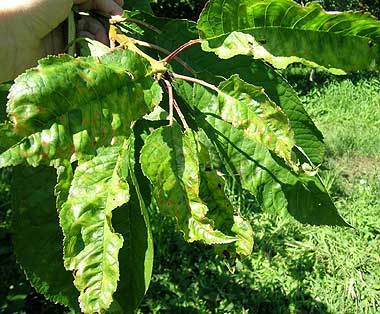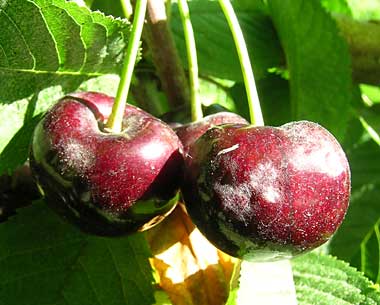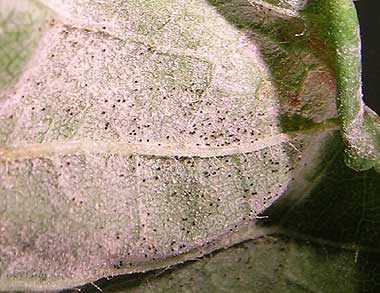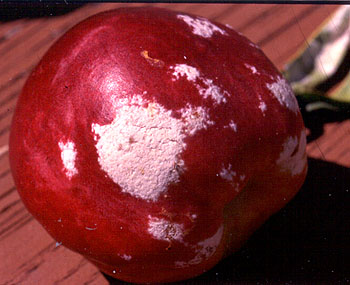Stone Fruit Powdery Mildew
There are several species of powdery mildew that attack tree fruit. Apple and pear are affected by Podosphaera leucotricha, while stone fruits are affected by Podosphaera clandestina and Sphaerotheca pannosa. Mildew can infect both the leaves and the fruit, and may render fruit unmarketable.
Cherry Powdery Mildew
Symptoms
Sweet Cherry: On leaves, powdery mildew appears as patches of white, powdery or felt-like fungal growth. Severely affected leaves and shoots are often puckered or distorted. Chasmothecia (fungal fruiting bodies) appear in older mildew colonies as small, black specks. Leaf infections are usually first observed about 4-6 weeks after bud break, and become increasingly obvious as the season progresses. Young leaves are more susceptible than mature leaves. Fruit infection appears as a white powdery bloom as the fruit ripens, or as roughly circular, slightly depressed areas on the fruit surface with or without any obvious growth of powdery mildew spores.
Sour Cherry: foliage is severely affected by powdery mildew most years. Visible fruit mildew may be more likely on late-harvest fruit.
 |
| Powdery mildew on sweet cherry leaves, causing yellow mottling and distortion |
 |
| Powdery mildew damage to sweet cherry fruit, cultivar 'Sweetheart' |
 |
| Powdery mildew growth on the underside of a sweet cherry leaf. Note black chasmothecia (overwintering fruiting bodies) |
Life Cycle
Powdery mildew overwinters as chasmothecia on leaf litter on the orchard floor, and trapped in tree crotches or bark crevices. Ascospores are released from the chasmothecia in response to rain or irrigation and provide the primary or first inoculum that infects cherry leaves or shoots in the spring. In Washington, ascospore release was found to begin one month before bud break, and continued until after bloom. Once mildew colonies have become established, a second type of spore (conidia) is produced. There are multiple generations of conidia produced all summer, potentially resulting in a rapid build-up of disease levels.
Fruit infection is caused by conidia that are produced on the leaves. Immature fruit is much more susceptible than mature fruit, and susceptibility decreases as sugar content increases.
Powdery mildew is favoured by moderate to warm and humid conditions, with optimal temperatures in the range of 15-25°C. Conidia are not produced below 10°C or above 30°C. Mildew severity is greater in years with frequent showers in late spring and early summer.
Cultural Control
- Prune for good air circulation. Avoid overly dense plantings.
- Remove infected water sprouts before full leaf.
- Keep grass mowed short to reduce humidity in the orchard.
Chemical Control
There are numerous fungicides registered for control of powdery mildew on sweet cherry. Please refer to the BC Tree Fruit Production Guide for current fungicide recommendations. Follow the product labels for application instructions and precautions.
Susceptible and late-harvest varieties and problem blocks:
- Begin a control program early, no later than bloom to petal fall, to protect emerging green tissue from airborne ascospores. Preventing or minimizing primary infections of foliage is important to prevent fruit infection later in the season.
- Continue fungicide coverage until harvest. Adjust spray intervals as needed depending on the rate of shoot growth, fungicides selected and weather conditions. More sprays will be needed in wet years than dry years.
- Consider post-harvest application of fungicides to prevent buildup of mildew on foliage and reduce the amount of overwintering inoculum. For these late season sprays it is best to select products that have a low risk of resistance, such as sulphur, bicarbonates or summer oil.
Less susceptible varieties and blocks without a history of mildew problems:
- Critical spray timings for fruit protection under normal conditions of light to moderate mildew pressure include fungicide applications at husk fall and about 7-10 days later to protect the susceptible green fruit.
- Fruit is most susceptible to mildew up to the pit hardening stage.
Research in Washington State has shown that lime sulphur applied to sweet cherry trees in the fall may be useful to reduce the overwintering populations of the fungus. This will not eliminate the need for fungicides during the growing season, but reducing initial inoculum will help to delay the build-up of disease levels and make fungicidal control more effective. Fall application of lime sulphur was found to be more effective than spring application in Washington. In Canada, lime sulphur is registered on cherry as a general clean-up dormant spray, as well as for San Jose scale, European scale and mites.
Peach and Nectarine Powdery Mildew
Symptoms
Powdery mildew appears in late spring or early summer as white mildew spots on the fruit and foliage. Later the spots on the fruit turn a tan colour. When severe, it may crack the fruit.
 |
| Powdery mildew on nectarine fruit |
Cultural Control
- Provide good air circulation through trees.
- Cling peaches, nectarines and seedling peaches are especially susceptible and can serve as a source of infection.
Chemical Control
- There are several fungicides registered for control of powdery mildew on peach and nectarine. Please refer to the BC Tree Fruit Production Guide for current fungicide recommendations. Follow the product labels for application instructions and precautions.
Apricot Powdery Mildew
Powdery mildew is not normally a problem on apricots, but may occassionally cause fruit russeting. Primary inoculum is thought to originate mainly from nearby peaches and infected roses.
There are several fungicides registered for control of powdery mildew on apricot. Please refer to the BC Tree Fruit Production Guide for current fungicide recommendations. Follow the product labels for application instructions and precautions. Do not apply sulphur to apricots as it will cause defoliation.
Updated July, 2018
Related Links
More Information
AgriService BC
Have a question? Call or email us.
Toll Free: 1-888-221-7141
E-mail: AgriServiceBC@gov.bc.ca
